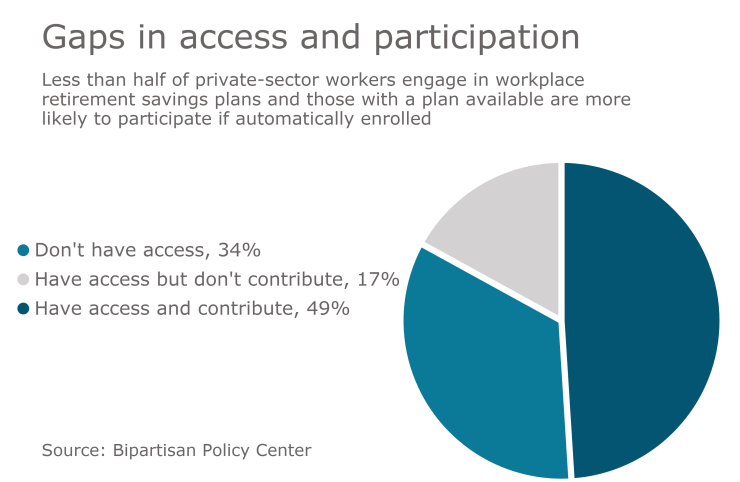Employees aren’t the only ones concerned about their ability to save for retirement — employers are seriously worried, too.
So says new research from TIAA, which found that plan sponsors are very concerned about their employees not being able to pay for healthcare expenses in retirement and outliving their retirement savings.
Nearly half of nonprofit and corporate for-profit employers say they are only somewhat confident in their employees’ retirement futures. Meanwhile, “the scary thing is that one in five are not confident at all,” says Tim Walsh, senior managing director, institutional investments at TIAA, quoting from the “2018 TIAA Plan Sponsor Retirement Survey.”
“We’ve heard for years now that employees and employers are worried about outliving their savings and about the retirement income gap in the U.S.,” he says. But the latest trend is worrying about
Seventy-five percent of employers are worried their employees aren’t saving enough, and 55% are concerned that their workers are not choosing to participate in the workplace retirement plan. Employers also must work within the confines of budget constraints while still trying to attract and retain good workers.

“While plan sponsors face a number of workforce challenges, employees outliving their retirement savings is a top concern,” says Doug Chittenden, executive vice president and president of Institutional Retirement at TIAA. “Creating a diversified retirement benefits menu that includes a lifetime income option will not only help ensure employees have enough money to cover basic expenses in retirement, it can also help alleviate the stress of rising healthcare costs.”
Walsh says that when asked, most employees and employers say they would like access to some form of guaranteed lifetime income for life. Fifty-one percent of employers believe their workers would prefer receiving $2,700 a month for life instead of a lump sum payment of $500,000 at retirement. An earlier TIAA survey of employees had the same result, with 62% of employees saying they would make the same choice.
The disconnect between the nonprofit and for-profit employers is that nonprofits are twice as likely to believe their employees would prefer monthly lifetime income over a lump sum, according to TIAA.
Currently, very few employees have access to a lifetime income option. According to the plan sponsor retirement survey, only 12% of employers offer annuities as retirement income options. The most common offerings are target-date funds, mutual funds and stable value funds, which rely on employees to spend down their assets.
Walsh says that embedding guaranteed income into retirement plan design is important.
“One of the things that came out of the survey is we are starting to see this pivot. Employers are not just thinking lump sum. They are thinking about monthly income, replacing their paycheck in retirement,” he says. “That’s a good trend. People are starting to think about monthly income, not just their account balance.”
Healthcare is the second big piece of the puzzle, and education is going to play a major role in that. Walsh suggests that employers do a better job of educating employees about healthcare costs in retirement.
“The message here is that planning for healthcare costs in retirement should be part of a comprehensive health and wealth strategy that helps employees pursue this holistic
Employers could offer retiree health savings vehicles, like HSAs, paired with a high-deductible health care plan to help cover their employer contributions and administrative costs sufficiently, Walsh adds.
On the guaranteed lifetime income side of the equation, the biggest question, from a fiduciary perspective, is how to get plan sponsors more comfortable in choosing lifetime income products, particularly annuities, he says.
Congress has looked at this topic extensively. A bill currently working its way through the Senate, the Retirement Enhancement and Savings Act of 2018, would simplify the annuity safe harbor and make it easier for plan sponsors to include lifetime income in their plans.
Both plan sponsors and their consultants need to be better educated about how to choose an insurance product, annuity or lifetime income product for their plans. Walsh says that it really isn’t a different process than choosing a mutual fund.
“Some of the numbers are different but the process is exactly the same,” he says. “It would be great to get a safe harbor, but it is incumbent on us to better educate plan sponsors and their consultants how to leverage these products.”
The big impediment to plans including a guaranteed lifetime income piece is that plan sponsors are still the ones responsible for looking at the financial viability of the different insurance companies, their ratings and experience.
“A lot of plan sponsors aren’t comfortable with that. RESA allows plan sponsors to leverage the experts, the experts being state regulators. They are constantly looking at these products. As long as the offering has been blessed by state regulators, that is the safe harbor,” Walsh says. “It is a terrific simplification. We are confident and hopeful we will get there, but that is absolutely a step in the right direction.”
TIAA believes that
TIAA’s plan sponsor survey found that 43% of plan sponsors have not analyzed their workforce demographics at all or only to a limited extent. The company believes that this is an important first step employers should take so they can better tailor their advice, education and other resources to better help employees plan for retirement.





